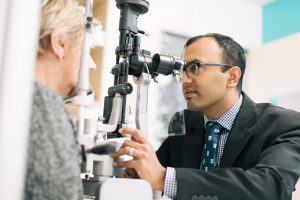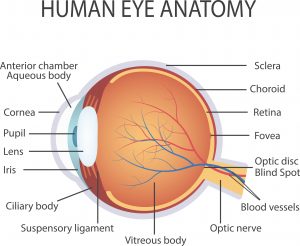Associate Professor Abhishek Sharma is a specialist in both medical and surgical retinal eye conditions at Queensland Eye Institute (QEI). His specialties include treatment for macular degeneration, diabetes, retinal detachments and other conditions affecting the back part of the eye.
Focused on the retina
When asked why he wanted to focus on retina related health, Associate Professor Abhishek Sharma explained, “I think the retina is an amazing tissue. The retina is the part of the eye that converts light to electrical signals. These signals go to the brain through the nerves and allow you to see. It’s where sight begins. To be able to treat the retina, either with medications or surgery, is a marvel in medicine. Through the retina, you can often see problems that affect the rest of the body, such as diabetes or infections, you can directly see the effect of many diseases.”
The macula, at the centre of the retina is responsible for giving a person the sharp and detailed vision needed for reading, watching TV and driving. Unfortunately, when the macula degenerates and the cells break down, they leave waste products in the eye which start to affect a person’s vision.
Age-related macular degeneration (AMD) is the most common type of macular degeneration. Another form of macular degeneration which affects children and young adults is called Stargardt disease or juvenile macular degeneration.
How does macular degeneration affect your vision?
“The early signs are distorted letters and lines. Macular degeneration makes the fine vision less clear and less well defined. If it is dry macular degeneration, it can slowly progress. However if it is wet it can progress much more quickly so early treatment, before it scars up, can stop the deterioration and even improve it in some cases. It is important to have your eyes checked if you notice any changes in your vision.”
Wet and dry macular degeneration & treatment
There are two main types of macular degeneration, wet and dry.
“Dry macular generation can become wet over time. Macular degeneration (wet) was the leading cause of blindness in western countries 10-15 years ago before treatment. This involves injections in the eye in order to control the leaking blood vessels at the back of the eye. Treatment is initially monthly then is extended out gradually once the macula is stabilized, unless the vision becomes so poor there is no benefit. At QEI, we are also taking part in a multicentre and multinational trial where implants are put into the eye that will release the medication for up to 8-9 months instead of the frequent injections.”
For dry macular degeneration, Associate Professor Abhishek Sharma explains, “Treatment consists of monitoring with an Amsler grid as well as looking after your lifestyle. This includes a healthy diet, not smoking, possibly adding vitamin pills for the eye specifically and talking to your optometrist or eye doctor. Unfortunately there is currently no specific proven treatment for dry macular degeneration. However we hope that in the future with the multicentre trials that QEI is currently involved in, we can offer more comprehensive treatment.”
Those at risk of macular degeneration
There is no specific genetic link to macular degeneration that has been detected. However, the biggest risks are age and smoking, the latter being a much more serious factor.
Being proactive with eye health
The key to avoiding macular degeneration is to be proactive. Annual check-ups at the optometrist after 50 years old and a healthy diet with regular exercise are vital to keeping your eyes healthy. As well as checking the health of the macula, this appointment will look for diabetes, cataracts and review your current prescription for glasses.

